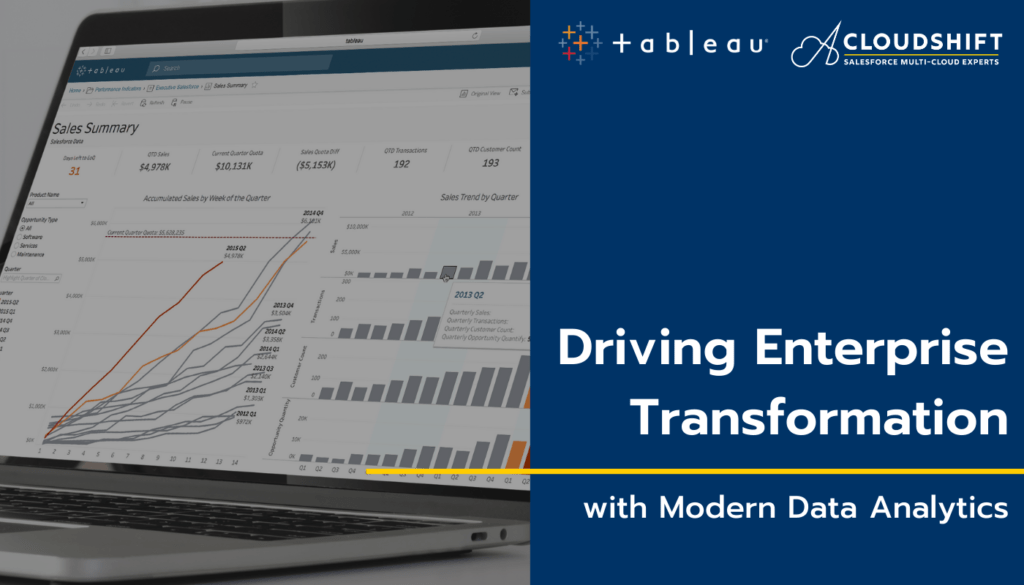The key factors that business leaders need to embrace when driving enterprise transformation have been uncovered in a recent investigation by Tableau. Find out what these factors are below and how you can use business intelligence software to power digital transformation below.
Cloud 3.0 is upon us and with it brings a whole host of necessities that businesses will need to invest in, in order to thrive. A key challenge that businesses are currently facing, and one that will only grow in significance, is how to leverage available data to fuel business growth.
While many organizations have upgraded or deployed new technology solutions in hopes of addressing their data challenges, they lack that propensity to pull data into their everyday business, weaving data-driven decision-making into the behavioural fabric of the organization’s operations.
Herein lies a critical gap between what organisations desire from their data and what their current data infrastructure is capable of. A new Whitepaper from Tableau investigates how business leaders can close this modern analytics gap and achieve true enterprise transformation.
Aligning the roles and responsibilities that empower a data-driven organization
In addition to having the right executive sponsorship, it’s important that businesses leaders recognise the importance of hiring and training data workers across all levels of the business. Solely hiring dedicated data analysts will result in a bottle neck of data leaving other employees with unanswered questions. However, only recruiting trained business users will result in the lack of a best practice model which will lead to messy unreportable data. These two groups, role-specific analysts and skilled departmental workers must be hired in conjunction with one another and work together cohesively, each supporting the role and efforts of the other.
Lowering barriers and making data easy and intuitive to consume is critical for employee adoption. Deeply focus trainings by using department-specific data, for example, will drive a higher level of interest during the learning process, and the additional business context will make the leap smaller for newer users or those struggling with the process.
Overcoming the challenges of adoption and governance at scale
Achieving data driven transformation through modern analytics must be viewed as a continuous journey, not a one-stop destination. The approach needs to be of an agile nature. Key here is to centre the transformation around people and culture and a shared vision of how analytics can inform the business. When deployed with this in mind modern Business Intelligence (BI) grants as little or as much change as the organization decides it’s ready for.
Even though most modern BI platforms are developed with ease of use and self-service front of mind there are still some common pitfalls to avoid when implementing BI.
Changing roles and responsibilities
- As organizations implement BI solutions, certain teams will begin to feel change almost immediately and this may cause suspicion. Teams such as IT, for example, should be involved and evolved into a true business partner, moving from producing data models and analytic content to more strategic enablement.
Data-minded leadership
- Leaders who default to instinct-based decision-making and rely solely on experience, rather than analytic insight, directly contribute to the poor adoption of BI in their organizations. BI teams are better served by leaders who understand the value of analytics and are willing and able to influence business process change.
ROI is perceived as unfulfilled after the analytics implementation
- If you see your BI deployment strategy as a “check-box type” project, you risk leaving learnings, growth, and the possibility of more success on the table. Instead of focusing on milestones like consolidating data from disparate sources or automating certain reports with more engaging dashboards, try to adopt more of an “art of the possible” mentality.
Embracing modern BI to deliver self-service analytics
Bring visual analysis and data exploration to the forefront of BI
Traditionally BI has served to help provide decision makers with answers in a questions and answer format. Questions are asked then IT-led departments generate reports and come back with the answers, each time a new question is asked the cycle is repeated to get additional insights. What modern BI offers is the ability to combine the visual and the data interface, this way data is explored as it is visualised so insights can be generated on the fly and pivoted when new questions arise.
Evaluate modern BI platforms with confidence
Following the above detailed strategy to transform your organisations through modern analytics will ultimately fail if the wrong BI platform is implemented across the business. Here are some vital areas to focus on when selecting what BI tool will meet the needs and goals of your business.
- Platform integration and accessibility – Can users access, interact with, analyze, discover, share, promote, and govern analytical content all seamlessly within the platform? Can this be done without IT involvement or specialized skills?
- Ease of use – Is the platform straightforward to install, configure and manage? Can content creators easily prepare and curate data sources and author new analytical content without upfront or ongoing assistance from IT? Can non-technical users find and interact with content, asking deeper questions or customizing content to suit their needs?
- User enablement – Are role-specific trainings, self-paced tutorials, online help resources, and professional services available for users? Is there a user community accessible to share best practices?
We hope you enjoyed our highlights and please download the full Whitepaper to get further details on how to drive enterprise transformations with modern data analytics.
As a Tableau Partner, CloudShift is here to help and advise so you can discover more about Tableau, the highly intuitive BI platform.





